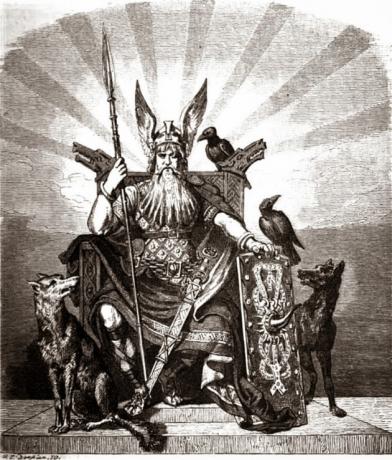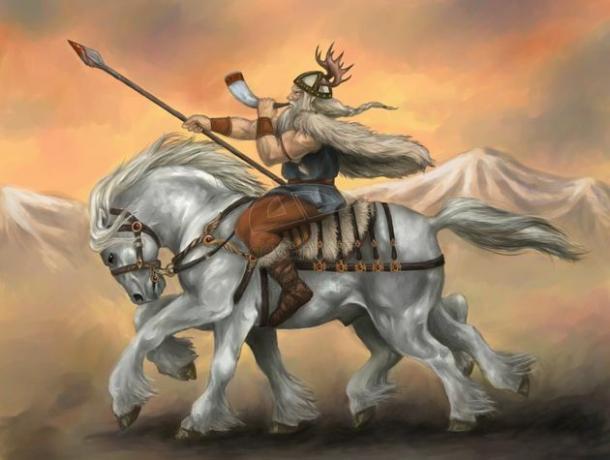Odin he is a Norse god, lord of healing, life and death. His cult spread across northern Europe and is called Wotan in Germanic mythology.
Pictured as an old man, with long white beard but robust, Odin sometimes appears dressed as a simple pilgrim or with his warrior weapons.
Odin's life
The figure of an elderly man who teaches humanity the knowledge of healing, agriculture and writing is present in the mythologies of many peoples.
The main source on Norse mythology is the Poetic Edda a set of poems that were passed down by oral tradition and recited at the festivals of the Nordic tribes.

Odin was the son of Bor and bestla (giant), but there isn't much information about his parents. He had two other brothers, see and vili, who presented humanity with gifts such as speech, emotions, among others.
However, to gain wisdom, Odin had to offer one of his eyes to mimir, the Guardian. So he could drink the liquid from the magic well of mimir and get the knowledge.
As Odin has the power to see everything that goes on in the nine worlds, he was jealous of the knowledge contained in the tree. Yggdrasil. So he wounded himself with a spear and hung for nine days on the branches of this tree.
After the ninth day, he understood the secret of the runes that gave him several abilities such as:
- Heal;
- Free yourself from any difficulty;
- Dodge arrows that are aimed at him;
- Calm winds, waves and storms;
- Make a warrior invincible;
- Assume any appearance: old, young, adult;
Runes
Runes are the alphabet used by Scandinavian peoples before the arrival of Christianity and its replacement by the Latin alphabet.
They also consisted of a kind of game to obtain self-knowledge, guidance and to know the will of the gods for a given matter. Only initiates could interpret the meaning of the runes.

Symbols and Party
His symbol is the solar cross and his main festival was the Winter Solstice. To gain Odin's favor, animals, usually males and humans, were sacrificed.
The ancient peoples had the custom of dedicating one day a week to each god and its Germanic name, Wotan, ended up entering the English language as "Wednesday".
address
Odin is the lord in Asgard and lives in the palace Valaskjalf, in a tall tower, where his magical throne, called the Hlidskialf. From there he can contemplate the nine worlds.
food
Odin doesn't need to eat and just drinks wine and mead, a special liquor. All the food that is put on his plate he gives to his wolves.
Animals

- Horse: rides a swift eight-legged horse, sleipnir, considered the most beautiful of all horses.
- crows: is always accompanied by two crows, Hugin and Munin, who spend the day flying around the world and in the afternoon come to sit down and tell the god everything they saw in their wanderings.
- Wolves:manage and freki they are the two wolves that accompany him wherever he goes. On the battlefields, animals take the opportunity to feed on corpses.
Weapon
Odin wields the spear Gungnir which has runes etched into its metal. When the god fires his weapon, it never misses the mark and always returns to your hands.
Sons
Odin is married to Frigg (or Freya) and is the father of countless gods such as Thor, Baldr, Vali, Hoder, Njord, Herod, Bragi, Tyr, Heindal, Vidor, and still the Valkyries.
Death
At the end of time, it will happen in Ragnarok a great fight between the gods and the deceased warriors who live in Valhalla.
Odin knows he will be killed by the wolf Fenrir, at the Battle of Ragnarok, when several gods too, including his son Thor, will perish.
Natural disasters will enshroud the land, however, it will not be the end, as the surviving human couple will repopulate it.
Interpretations on the figure of Odin
The figure of Odin/Wotan is controversial when interpreted in light of the christianity. Far from being the benevolent god, Odin's personality is as complex as any human being.
Likewise, each people and each age worshiped an aspect of Odin's character. Thus, Odin was a warrior in times of war, but the healer, after battle.
The lord of life when the crops were good, but the vengeful god if there was a shortage of food.
With the arrival of Christianity, the Church's tendency was to demonize the figure of the gods and emphasize only the negative aspects.
Romanticism
During the 19th century, with the Romantic movement, Germanic legends regained their popularity through publications.
Likewise, the works of the German composer Richard Wagner (1813-1883) and his cycle "The Ring of the Nibelungs" where it tells the saga of the gods through four operas.
Curiosities about Odin
- The god Odin and his family continue to inspire films like the trilogy around the character Thor, by Kenneth Branagh, 2011.
- The Gandalf character, from the series "Lord of the Rings" would have been inspired by Odin.
- Samsung company named one of its software "Odin".
read more:
- Germanic Peoples
- Scandinavia
- the Vikings
- Paganism
- Weekdays in English
- What is mythology?
